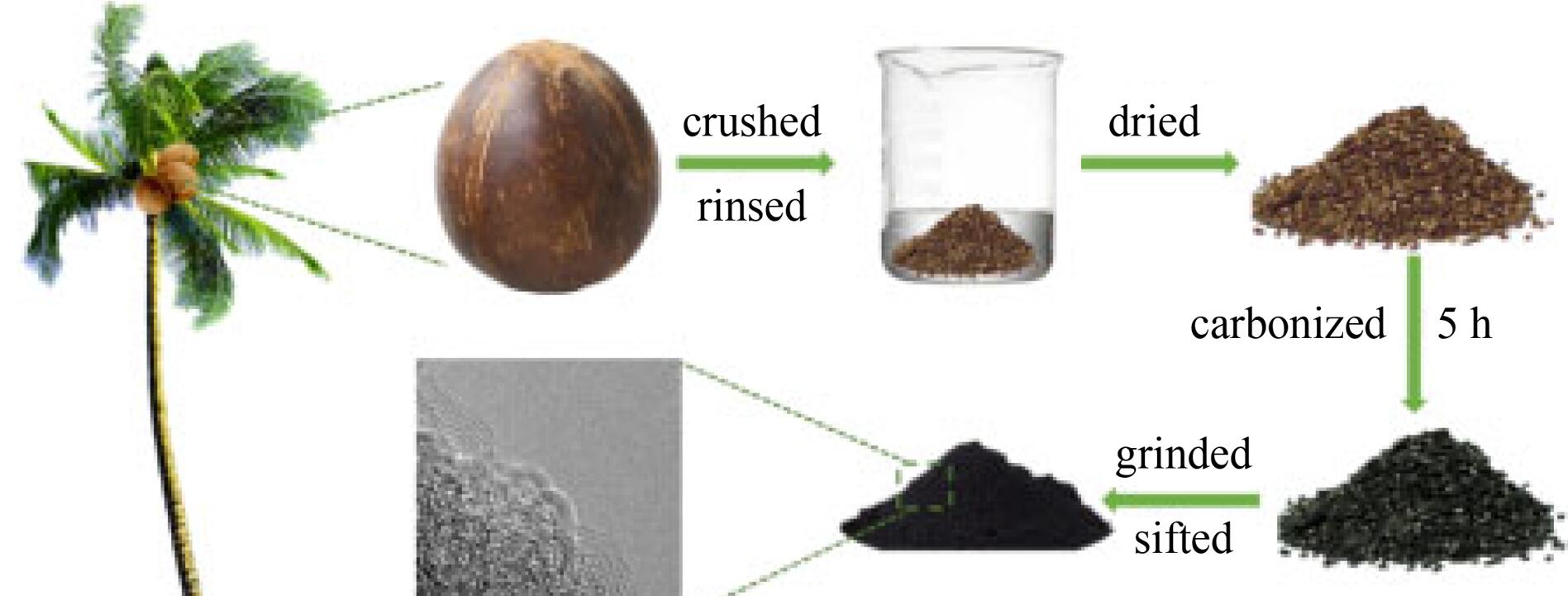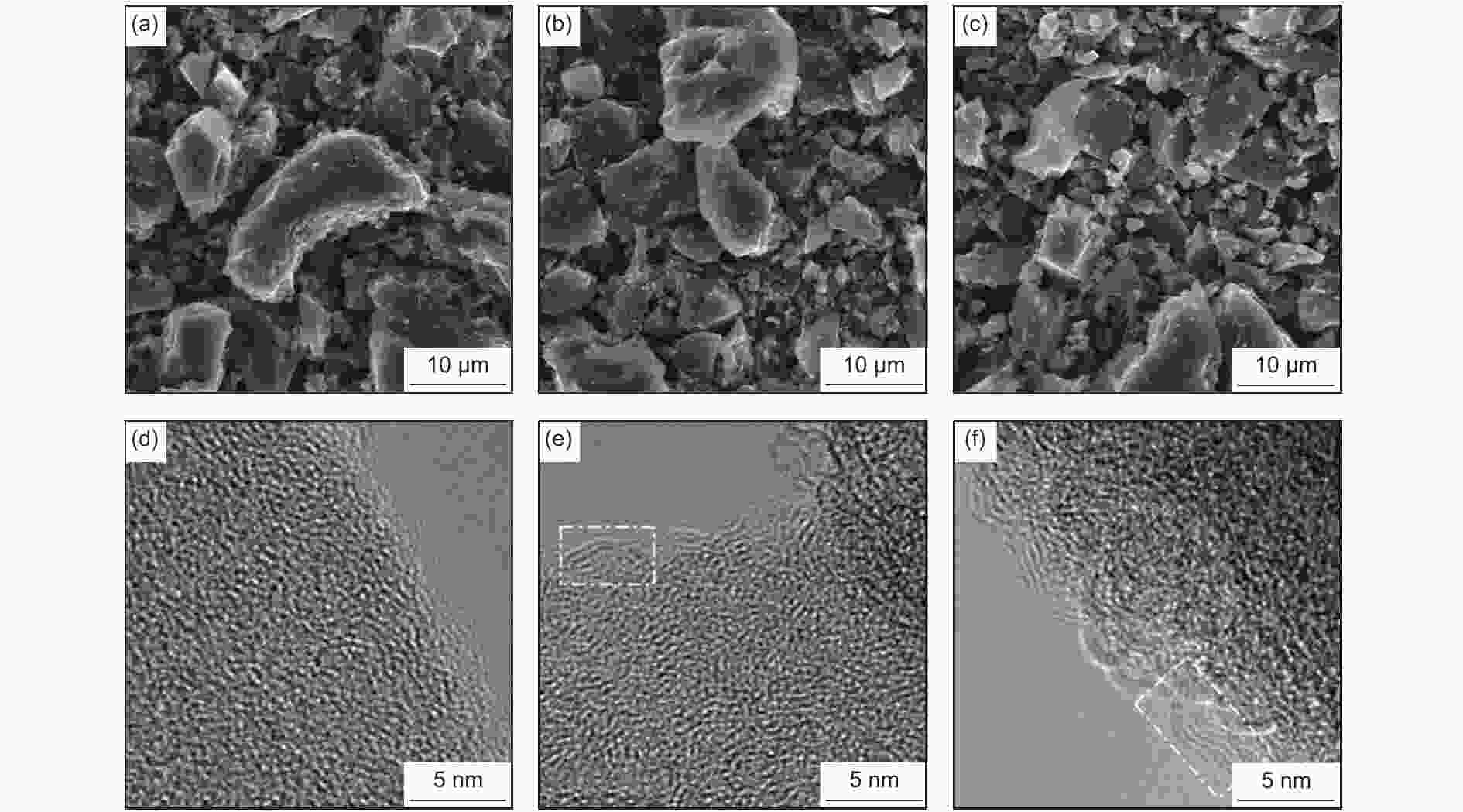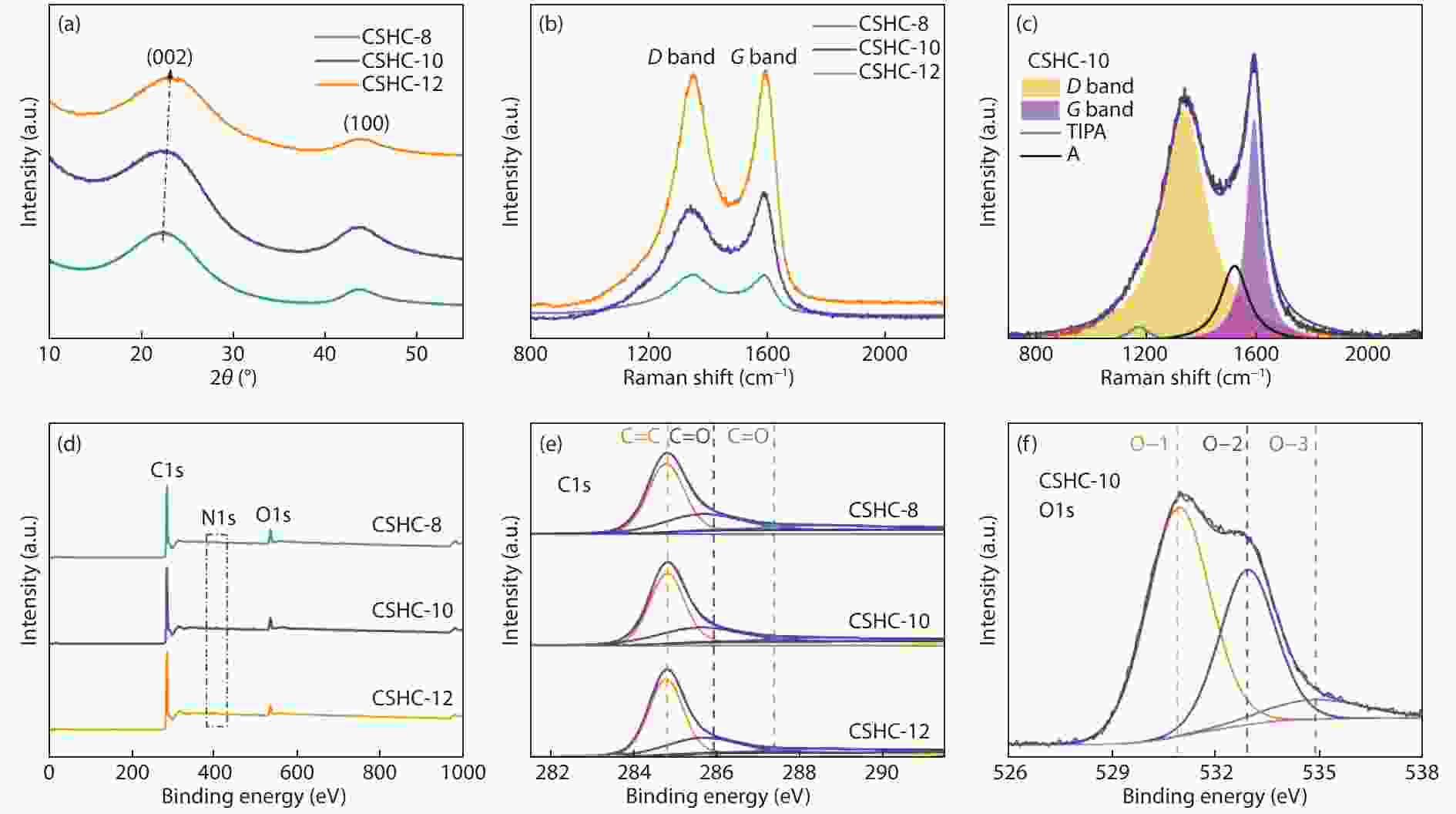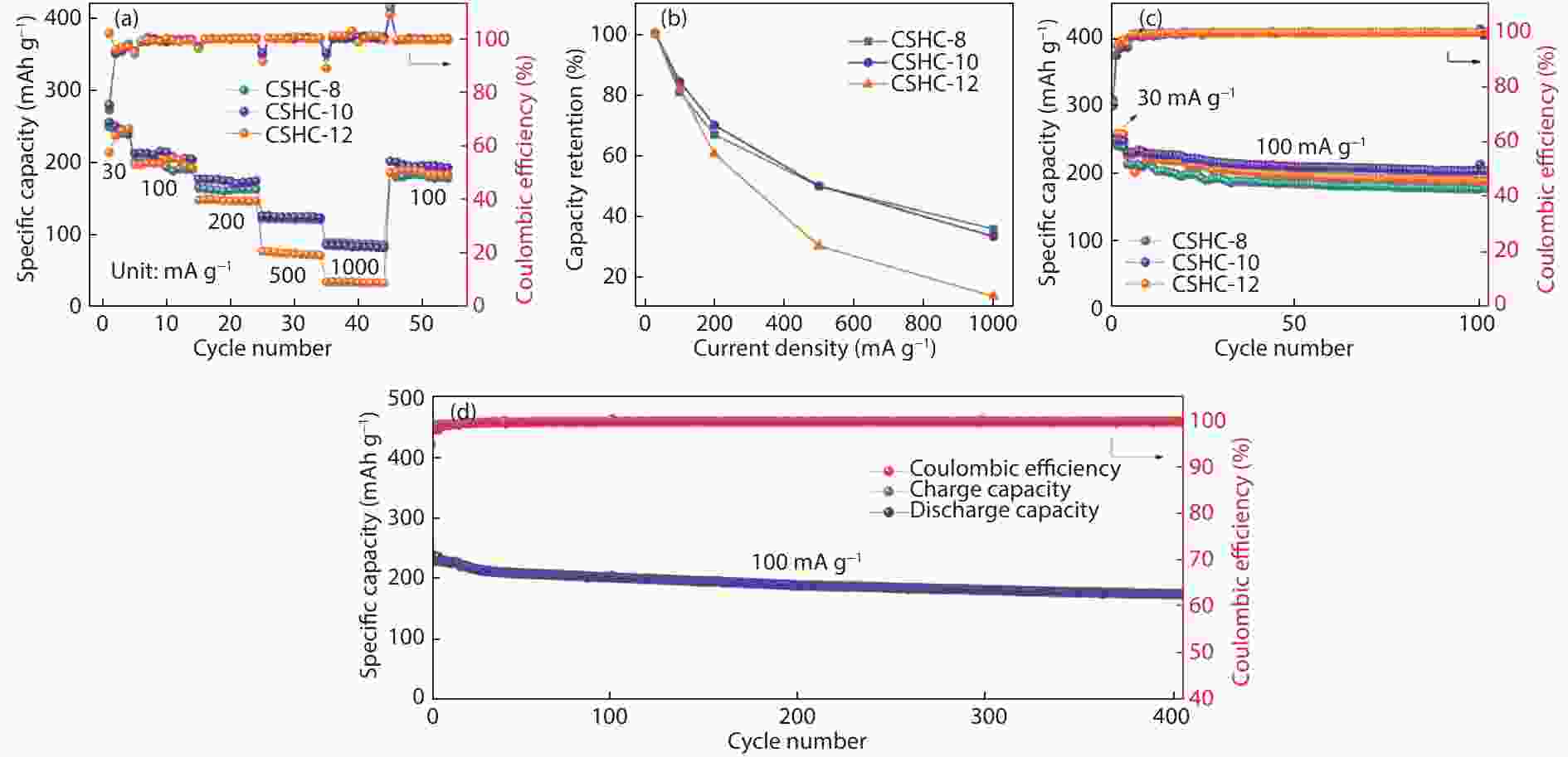Microstructures and electrochemical properties of coconut shell-based hard carbons as anode materials for potassium ion batteries
-
摘要: 生物质硬炭用作钾离子电池负极材料具有可逆容量高等特点,但较高的制备成本及较低的循环稳定性限制了其大规模应用。本文以废弃生物质椰壳为前驱体通过一步热解法制备椰壳基硬炭(CSHC)并作为钾离子电池负极材料。通过X射线衍射仪、N2吸脱附仪、拉曼光谱仪、扫描电子显微镜、透射电子显微镜和循环伏安法等考察了炭化温度对椰壳基硬炭微观结构及电化学性能的影响。结果表明,在1000 °C下炭化所得的椰壳基硬炭具有合适的石墨微晶尺寸、孔隙结构及表面缺陷含量,表现出最佳的电化学性能:在30 mA·g−1的电流密度下具有254 mAh·g−1的可逆比容量及75%的首次库伦效率,在100 mA·g−1的电流密度下循环100周后容量保持率为87.5%,循环400周后容量保持率达到了75%。说明所制备的椰壳基硬炭具有较高的可逆容量以及循环寿命,是一种电化学性能优异的储钾材料。Abstract: Hard carbons have recently attracted wide interest as anode materials for potassium ion batteries (PIBs) because of their high reversible capacity. But, their high preparation cost and poor cycling stability prevent their practical use. Coconut shell-derived hard carbons (CSHCs) were prepared from waste biomass coconut shell using a one-step carbonization method, and were used as anode materials for potassium ion batteries. The effects of the carbonization temperature on the microstructures and electrochemical properties of the CSHCs were investigated by X-ray diffraction, nitrogen adsorption, Raman spectroscopy, scanning electron microscopy, transmission electron microscopy, and cyclic voltammetry, etc. Results indicate that the CSHC carbonized at 1 000 °C (CSHC-10) has a suitable graphite microcrystal size, pore structure and surface defect content, and has the best electrochemical performance. Specifically, it has a high reversible specific capacity of 254 mAh·g−1 at 30 mA·g−1 with an initial Coulombic efficiency of 75.0%, and the capacity retention rates are 87.5% after 100 cycles and 75.9% after 400 cycles at 100 mA·g−1, demonstrating its excellent potassium storage performance.
-
Table 1. The structural parameters and XPS element analysis of the CSHCs prepared at different carbonization temperatures
Samples SBET (m2·g−1) Vpore (cm3·g−1) d002 (nm) Lc (nm) La (nm) ID/IG XPS analysis C O N C―C C―OH C=O CSHC-8 217.5 0.149 0.389 1.04 5.89 3.26 88.79% 10.24% 0.97% 59.12% 29.83% 11.04% CSHC-10 78.5 0.061 0.386 1.15 6.52 2.95 89.52% 9.54% 0.94% 59.63% 29.71% 10.65% CSHC-12 9.3 0.011 0.377 1.24 7.40 2.60 91.19% 7.85% 0.95% 61.33% 27.05% 11.62% Table 2. The fitting values of the resistance components in the equivalent circuit
Samples RS (Ω) RF (Ω) Rct (Ω) CSHC-8 1.3 186.4 95.9 CSHC-10 5.2 56.2 535.5 CSHC-12 4.6 11.7 772.9 -
[1] Fan S S, Liu H, Liu Q, et al. Comprehensive insights and perspectives into the recent progress of electrode materials for non-aqueous K-ion battery[J]. Journal of Materiomics,2020,6(2):431-454. doi: 10.1016/j.jmat.2020.02.007 [2] Yang M, Dai J, He M, et al. Biomass-derived carbon from Ganoderma lucidum spore as a promising anode material for rapid potassium-ion storage[J]. Journal of Colloid and Interface Science,2020,567:256-263. doi: 10.1016/j.jcis.2020.02.023 [3] Gao C, Wang Q, Luo S, et al. High performance potassium-ion battery anode based on biomorphic N-doped carbon derived from walnut septum[J]. Journal of Power Sources,2019,415:165-171. doi: 10.1016/j.jpowsour.2019.01.073 [4] Wang Q, Gao C, Zhang W, et al. Biomorphic carbon derived from corn husk as a promising anode materials for potassium ion battery[J]. Electrochimica Acta,2019,324:134902. doi: 10.1016/j.electacta.2019.134902 [5] Wu Z, Wang L, Huang J, et al. Loofah-derived carbon as an anode material for potassium ion and lithium ion batteries[J]. Electrochimica Acta,2019,306:446-453. doi: 10.1016/j.electacta.2019.03.165 [6] Alvin S, Chandra C, Kim J. Extended plateau capacity of phosphorus-doped hard carbon used as an anode in Na-and K-ion batteries[J]. Chemical Engineering Journal,2019:123576. [7] Prabakar S J R, Han S C, Park C, et al. Spontaneous formation of interwoven porous channels in hard-wood-based hard-carbon for high-performance anodes in potassium-ion batteries[J]. Journal of The Electrochemical Society,2017,164(9):A2012. doi: 10.1149/2.1251709jes [8] Chen C, Wang Z, Zhang B, et al. Nitrogen-rich hard carbon as a highly durable anode for high-power potassium-ion batteries[J]. Energy Storage Materials,2017,8:161-168. doi: 10.1016/j.ensm.2017.05.010 [9] He X, Liao J, Tang Z, et al. Highly disordered hard carbon derived from skimmed cotton as a high-performance anode material for potassium-ion batteries[J]. Journal of Power Sources,2018,396:533-541. doi: 10.1016/j.jpowsour.2018.06.073 [10] Chen C, Wu M, Wang Y, et al. Insights into pseudographite-structured hard carbon with stabilized performance for high energy K-ion storage[J]. Journal of Power Sources,2019,444:227310. doi: 10.1016/j.jpowsour.2019.227310 [11] Rout T, Pradhan D, Singh R K, et al. Exhaustive study of products obtained from coconut shell pyrolysis[J]. Journal of environmental chemical engineering,2016,4(3):3696-3705. doi: 10.1016/j.jece.2016.02.024 [12] Hwang Y J, Jeong S K, Shin J S, et al. High capacity disordered carbons obtained from coconut shells as anode materials for lithium batteries[J]. Journal of Alloys and Compounds,2008,448(1-2):141-147. doi: 10.1016/j.jallcom.2006.10.036 [13] Miao Y L. Structure-controlled carbon as anode materials for sodium ion batteries[D]. Tianjin University, 2017. [14] Sun Y, Wang L, Li Y, et al. Design of red phosphorus nanostructured electrode for fast-charging lithium-ion batteries with high energy density[J]. Joule,2019,3(4):1080-1093. doi: 10.1016/j.joule.2019.01.017 [15] Tian W, Wang L, Huo K, et al. Red phosphorus filled biomass carbon as high-capacity and long-life anode for sodium-ion batteries[J]. Journal of Power Sources,2019,430:60-66. doi: 10.1016/j.jpowsour.2019.04.086 [16] Park J W, Kim I, Kim K W, et al. Effect of commercial activated carbons in sulfur cathodes on the electrochemical properties of lithium/sulfur batteries[J]. Materials Research Bulletin,2016,82:109-114. doi: 10.1016/j.materresbull.2016.03.030 [17] Ju Z, Zhang S, Xing Z, et al. Direct synthesis of few-layer F-doped graphene foam and its lithium/potassium storage properties[J]. ACS applied materials & interfaces,2016,8(32):20682-20690. [18] Wang Q, Zhu X, Liu Y, et al. Rice husk-derived hard carbons as high-performance anode materials for sodium-ion batteries[J]. Carbon,2018,127:658-666. doi: 10.1016/j.carbon.2017.11.054 [19] Li Z, Jian Z, Wang X, et al. Hard carbon anodes of sodium-ion batteries: undervalued rate capability[J]. Chemical Communications,2017,53(17):2610-2613. doi: 10.1039/C7CC00301C [20] Fan S J, Tan R X, Xie X M, et al. Synthesis, morphology and structure of CVD graphene produced by a slit method[J]. New Carbon Materials,2018,33(6):522-528. [21] Cançado L G, Takai K, Enoki T, et al. General equation for the determination of the crystallite size La of nanographite by Raman spectroscopy[J]. Applied Physics Letters,2006,88(16):163106. doi: 10.1063/1.2196057 [22] Li X, Zeng X, Ren T, et al. The transport properties of sodium-ion in the low potential platform region of oatmeal-derived hard carbon for sodium-ion batteries[J]. Journal of Alloys and Compounds,2019,787:229-238. doi: 10.1016/j.jallcom.2019.02.077 [23] Zhou C, Wang D, Li A, et al. Three-dimensional porous carbon doped with N, O and P heteroatoms as high-performance anode materials for sodium ion batteries[J]. Chemical Engineering Journal,2020,380:122457. doi: 10.1016/j.cej.2019.122457 [24] Hulicova-Jurcakova D, Seredych M, Lu G Q, et al. Combined effect of nitrogen-and oxygen-containing functional groups of microporous activated carbon on its electrochemical performance in supercapacitors[J]. Advanced functional materials,2009,19(3):438-447. doi: 10.1002/adfm.200801236 [25] Lotfabad E M, Kalisvaart P, Kohandehghan A, et al. Origin of non-SEI related coulombic efficiency loss in carbons tested against Na and Li[J]. Journal of Materials Chemistry A,2014,2(46):19685-19695. doi: 10.1039/C4TA04995K [26] Lin X, Liu Y, Tan H, et al. Advanced lignin-derived hard carbon for Na-ion batteries and a comparison with Li and K ion storage[J]. Carbon,2020,157:316-323. doi: 10.1016/j.carbon.2019.10.045 [27] Lin X, Huang J, Zhang B. Correlation between the microstructure of carbon materials and their potassium ion storage performance[J]. Carbon,2019,143:138-146. doi: 10.1016/j.carbon.2018.11.001 [28] Wang Y, Wang Z, Chen Y, et al. Hyperporous Sponge Interconnected by Hierarchical Carbon Nanotubes as a High-Performance Potassium-Ion Battery Anode[J]. Advanced Materials,2018,30(32):1802074. doi: 10.1002/adma.201802074 [29] Zhang Y, Yang L, Tian Y, et al. Honeycomb hard carbon derived from carbon quantum dots as anode material for K-ion batteries[J]. Materials Chemistry and Physics,2019,229:303-309. doi: 10.1016/j.matchemphys.2019.03.021 [30] Yang I, Kim S G, Kwon S H, et al. Relationships between pore size and charge transfer resistance of carbon aerogels for organic electric double-layer capacitor electrodes[J]. Electrochimica Acta,2017,223:21-30. doi: 10.1016/j.electacta.2016.11.177 [31] Lei C, Markoulidis F, Ashitaka Z, et al. Reduction of porous carbon/Al contact resistance for an electric double-layer capacitor (EDLC)[J]. Electrochimica acta,2013,92:183-187. doi: 10.1016/j.electacta.2012.12.092 [32] Barroso Bogeat A. Understanding and tuning the electrical conductivity of activated carbon: A state-of-the-art review[J]. Critical Reviews in Solid State and Materials Sciences,2019:1-37. [33] Tai Z, Zhang Q, Liu Y, et al. Activated carbon from the graphite with increased rate capability for the potassium ion battery[J]. Carbon,2017,123:54-61. doi: 10.1016/j.carbon.2017.07.041 -






 下载:
下载:










